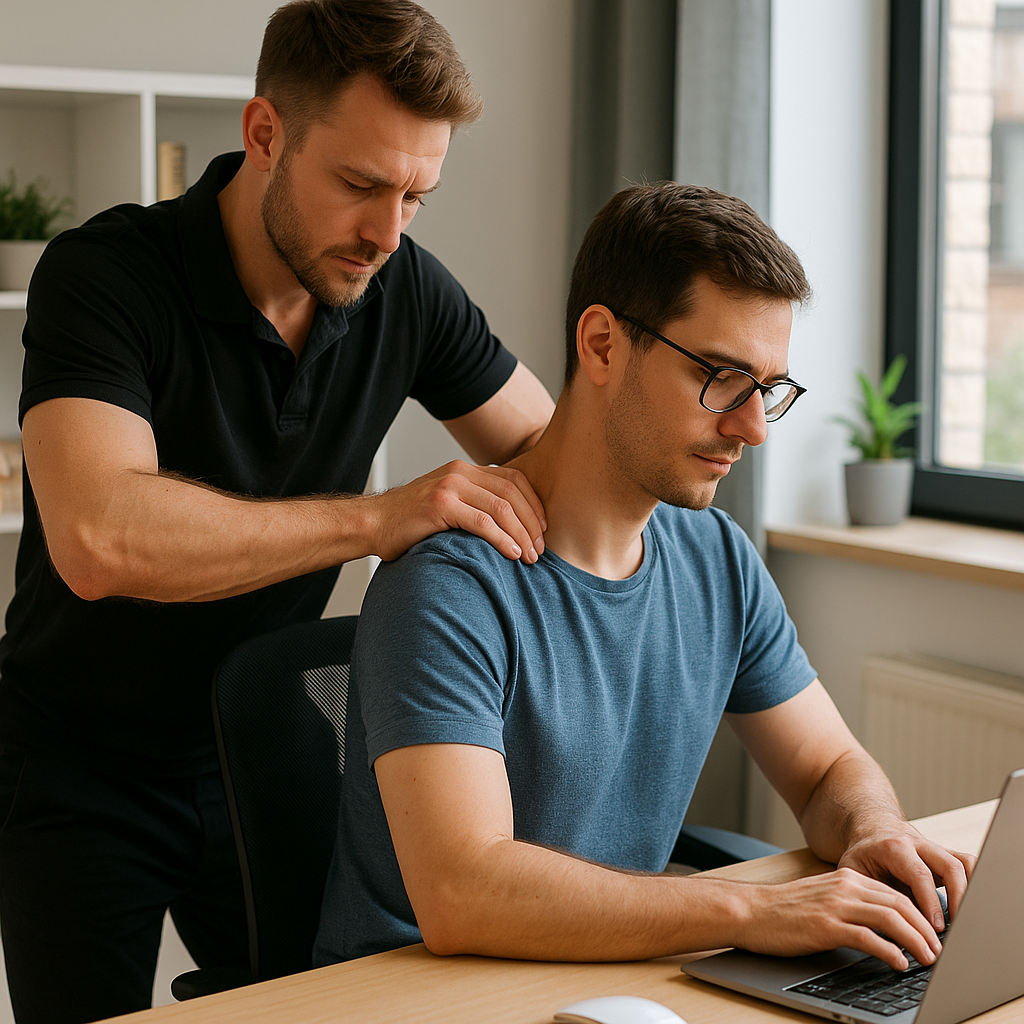
The physical toll of screen time is more than just eye strain — it’s changing the way we move, sit, and function daily. Massage therapy is emerging as a crucial support to balance our increasingly digital lives.
The Posture Problem Behind Our Screens
From remote work setups to non-stop scrolling, many of us are unknowingly compromising our bodies while interacting with tech. What starts as a minor ache in the neck or lower back can spiral into long-term postural dysfunction, tension headaches, or nerve impingement.
Australians now spend an average of over 6 hours per day on screens, and that doesn’t include hours spent sitting for work or study. Digital ergonomics — the design and arrangement of tech in a way that supports the body — is gaining attention. However, adjusting your chair or buying a standing desk may not be enough.
Digital Ergonomics 101: More Than Just the Right Chair
Digital ergonomics refers to the science of optimising how we interact with digital devices to reduce physical strain. It includes proper monitor height, keyboard placement, foot support, and posture corrections to support the spine and reduce tension.
But while workplace assessments and ergonomic improvements do help prevent injury, they may not undo the existing muscle tightness, inflammation, or nerve irritation that’s already developed. That’s where massage therapy may play a deeper role — not just as relief, but as part of a sustainable recovery approach.
If you’re curious about other human-technology intersections, DownGPT’s feature on AI-enhanced workplace productivity highlights how tech may also assist in managing our workload — but our bodies still need real-world care.
Massage Therapy: Not Just a Luxury, But a Tool for Correction
Massage therapy isn’t only for relaxation. It has clinically recognised benefits in supporting circulation, releasing tension, and reducing the body’s physiological stress response. For digital workers, it specifically targets issues like:
- Tech neck: Tightness in the neck and shoulders due to constantly looking down at phones or laptops
- Upper cross syndrome: Imbalance caused by prolonged sitting with rounded shoulders and a forward head
- Lower back strain: Often triggered by unsupported lumbar curvature and prolonged hip flexion
Different massage styles may be applied depending on the severity and nature of discomfort. Trigger point therapy, for example, may assist in treating referred pain from overused postural muscles, while myofascial release may support loosening up tight fascia built from repetitive motion.
The Hands-On Bridge Between Ergonomics and Health
While ergonomic setup deals with prevention, massage therapy focuses on recovery and function. The two work better together than in isolation.
By supporting tissue recovery, releasing muscle tension, and improving postural awareness, massage therapy can help digital professionals maintain alignment, reduce the frequency of injury, and function better within their current tech-heavy environments.
In some cases, massage may also complement broader physiotherapy programs that involve manual therapy, exercise prescription, and functional retraining.
If chronic strain is affecting your daily routine, Next Wave Therapy’s trusted massage therapy support may assist. Their approach integrates remedial massage with clinical physiotherapy, giving clients a clear pathway toward lasting musculoskeletal health — particularly relevant for those working long hours at desks or on devices.
Digital Strain in the Real World: Common Scenarios
Let’s look at common digital lifestyles and how massage therapy fits in:
1. The Remote Worker:
They’ve got two monitors, a poorly adjusted chair, and meetings back-to-back. Over time, shoulder elevation and neck tension build up. Massage can target the levator scapulae and trapezius muscles to reduce inflammation and prevent headaches.
2. The Developer or Gamer:
Long hours at the screen, repetitive mouse clicks, and a forward head position. Massage therapy may support relief for carpal tunnel syndrome and help rebalance anterior shoulder rotation.
3. The Social Scroller:
Hours spent on phones creates downward cervical strain. Manual therapy may help decompress the cervical spine and reduce muscle compression.
Each of these examples shows that minor lifestyle habits can lead to significant physical changes — often unnoticed until pain or restriction appears.
At-Home Measures to Pair With Professional Treatment
While booking a professional massage session is beneficial, some habits at home may extend its effectiveness. These include:
- Daily microbreaks: Standing and stretching every 30–60 minutes
- Foam rolling: Gentle self-myofascial release for the upper back or glutes
- Self-massage tools: Lacrosse balls, neck stretchers, or handheld percussion devices
- Posture tracking apps: Tools that provide visual feedback or reminders
For a deeper understanding of how tech can actually support better posture and routine, DownGPT’s article on wearable health technology trends is a useful resource.
But while tech may nudge you to stretch, only skilled hands can identify specific muscle patterns and tailor treatment to your needs.
Signs You May Benefit from Massage Therapy
If you’re experiencing the following symptoms regularly, it may be time to seek clinical support:
- Ongoing tightness or pain in the upper back, neck, or lower back
- Numbness or tingling in fingers or arms (possible nerve involvement)
- Headaches stemming from tension or poor posture
- Limited shoulder, neck, or hip mobility
- Sleep disturbance due to discomfort
Early intervention with massage therapy can help prevent these symptoms from escalating into long-term issues.
Final Thoughts: Massage Therapy as a Digital Lifestyle Tool
Massage therapy is no longer just for athletes or spa-goers — it’s becoming increasingly relevant for professionals, students, and creatives who live most of their lives in front of screens. By reducing muscular tension, improving blood flow, and helping correct posture, it serves as a crucial counterbalance to digital habits.
Combining massage therapy with a well-set-up workspace and movement-based strategies may offer long-term benefits — not just physically, but mentally as well.
If your body is paying the price for your digital success, integrating supportive care through services like Next Wave Therapy’s trusted massage therapy support may help keep you productive, pain-free, and moving well — online and offline.